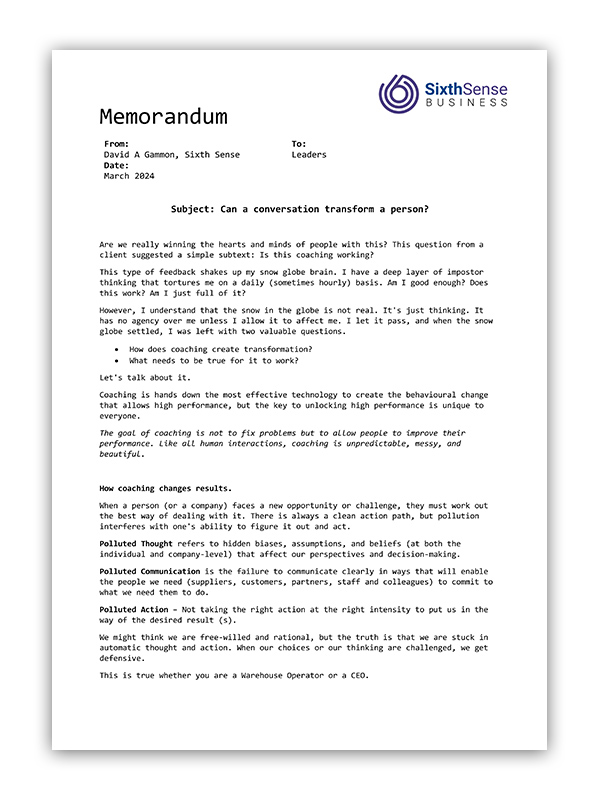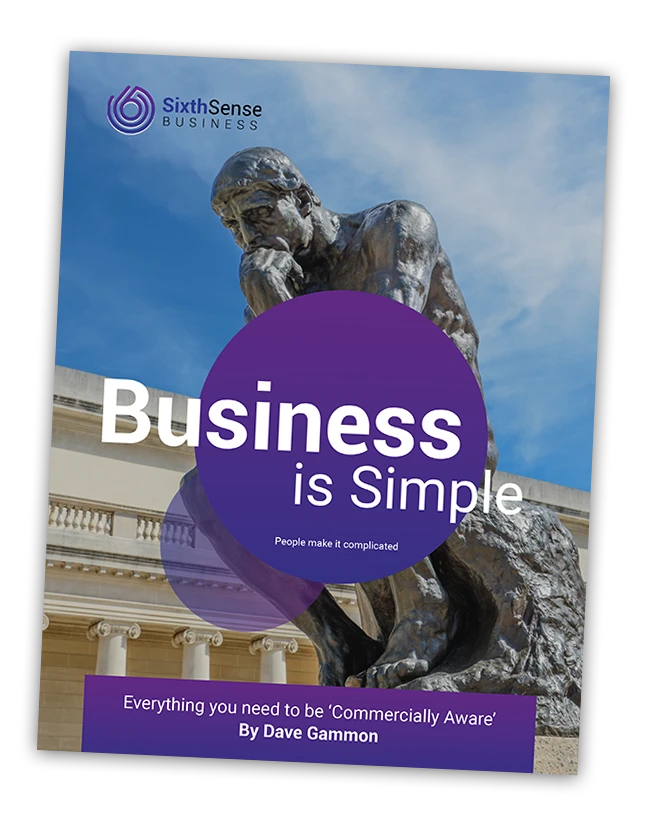From:
David A Gammon, Sixth Sense
To:
Leaders
Date:
March, 2023
Are we really winning the hearts and minds of people with this? This question from a client suggested a simple subtext: Is this coaching working?
This type of feedback shakes up my snow globe brain. I have a deep layer of impostor thinking that tortures me on a daily (sometimes hourly) basis.
Am I good enough?
Does this work?
Am I just full of it?
However, I understand that the snow in the globe is not real. It’s just thinking. It has no agency over me unless I allow it to affect me. I let it pass, and when the snow globe settled, I was left with two valuable questions.
- How does coaching create transformation?
- What needs to be true for it to work?
Let’s talk about it.
Coaching is hands down the most effective technology to create the behavioural change that allows high performance, but the key to unlocking high performance is unique to everyone.
The goal of coaching is not to fix problems but to allow people to improve their performance. Like all human interactions, coaching is unpredictable, messy, and beautiful.
How coaching changes results
When a person (or a company) faces a new opportunity or challenge, they must work out the best way of dealing with it. There is always a clean action path, but pollution interferes with one’s ability to figure it out and act.
Polluted Thought refers to hidden biases, assumptions, and beliefs (at both the individual and company-level) that affect our perspectives and decision-making.
Polluted Communication is the failure to communicate clearly in ways that will enable the people we need (suppliers, customers, partners, staff and colleagues) to commit to what we need them to do.
Polluted Action – Not taking the right action at the right intensity to put us in the way of the desired result (s).
We might think we are free-willed and rational, but the truth is that we are stuck in automatic thought and action. When our choices or our thinking are challenged, we get defensive.
This is true whether you are a Warehouse Operator or a CEO.
The solution is a thinking partner[i] to help us examine and challenge the thinking driving our perspectives and choices. But it’s not just any person or conversation; it’s a transformational coaching conversation.
That’s where I come in. But for coaching to succeed, several things must be true.
The conditions for success with coaching
Willingness – To be coached, we must be willing to explore our thinking in ways that can sometimes feel uncomfortable. We are naturally defensive about our identities, deepest beliefs, and values, yet this is where transformative breakthroughs happen.
Trust—Coaching conversations need to be a space for people to say what they genuinely think and feel. This requires trust, which comes from an environment of complete confidentiality (especially when working with multiple people in a company), zero judgment, and a desire to bring out the best in the coach.
Belief—Coaching works differently for different people. Lasting change happens when people have transformational insights. The ideas that lead to insights are often the after-effects of coaching rather than explicitly discussed and learned in the coaching session.
Time—It takes each of us our whole lives to develop the thinking and behaviours that got us where we are. Now and again, I have seen incredible transformation happen in just a few sessions, but that is the exception to the rule. Creating a powerful and lasting transformation usually takes time and sustained effort.
Competence – It’s my job to ensure my skills remain current[ii] and that I apply them as consistently as possible. But I am human, and sometimes, my advice monster inadvertently gets in the way of coaching the person.
If all these things are true, then coaching has a chance to profoundly impact individuals and company performance. It is never not valuable.

